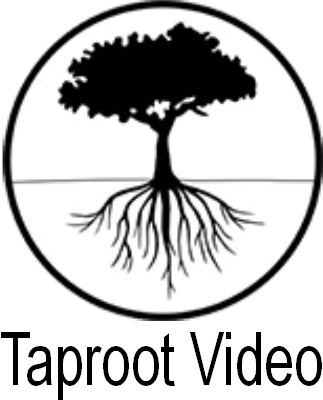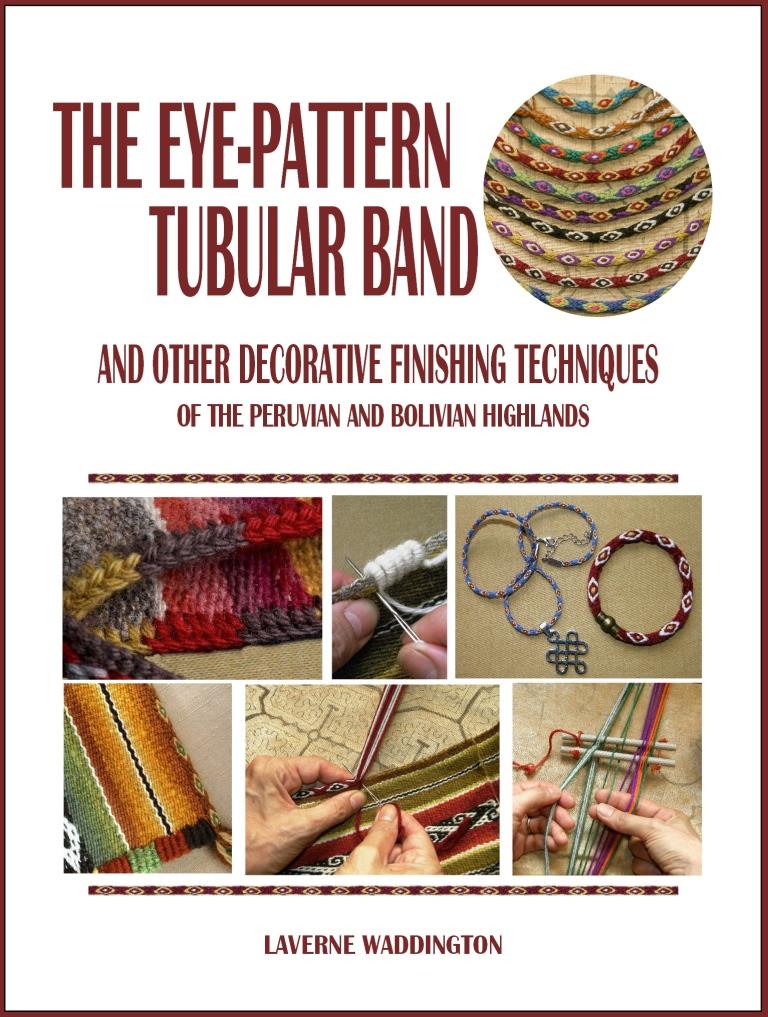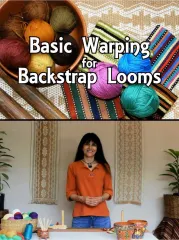I have put the full tutorial for the simple warp float technique shown above on a new tutorial page along with two videos I made that show the process. In this technique, warps of one color form a design which sits on a background of horizontal stripes. By working slowly through the steps and the two follow up tutorials on warp floats, you will build up the skills necessary to weave the kinds of pieces where floats of two colors are used to completely cover the surface of the weaving. This is the technique used in the yurt band piece below.
My yurt band reproduction moved along this week and, after having done a couple of repeats of the design, I decided that I had had enough practice on this piece and that I would make a new warp adding some plain weave and weave it again to make something useful. So it has finished up like most of my samples with a zip and will be used to store stuff or gifted. Actually, I wouldn’t mind weaving it this size again but on a much longer warp and sewing it onto brown suede for a laptop bag.
Now to chart the designs on these other yurt band pieces. I know I have shown these here before but they are well worth another look…so gorgeous! The designs are very similar and, after having charted the one above, I am sure that it won’t be too hard to do these.
Chris Buckley in Beijing was kind enough to allow me to use these images of yurt bands in his collection. The band immediately above left belongs to Lisa and Ryan Matthews. Remember that there are tutorials on my blog for weaving the red and white border design as well as the yellow and brown one.
 I got a little braiding time in this week too but couldn’t find the Margarita braid that I had started for the tutorial I posted here. I suspect my cat made off with it during the night so I made another.
I got a little braiding time in this week too but couldn’t find the Margarita braid that I had started for the tutorial I posted here. I suspect my cat made off with it during the night so I made another.
Braiding is fun but I have never really used the braids for anything. One is being used to hang one of my weavings on the wall.
This braid I am working on now in the 12wpi cotton is so thick and sturdy I am sure it will make a brilliant bag handle. So I will make the braid and then think about a bag to match – kind of putting the cart before the horse.
I had started a Palma braid some time ago to use as a handle for an existing bag but the colors were not a good match and that idea was abandoned.
These are the two main braiding styles I learned with a sling braider in Peru many years ago.
Here is a summary of the steps to this braid following on from the original tutorial here:
Part 1,2,3,4,1,2,4,3,2,1,4,3,2,1,3,4,1,2,3,4,1,2,4,3,2,1,4,3,2,1,3,4,1,2, etc……..
This is turning out to be a very red dominated page especially with this, my latest project…
This is both faces of a piece that is destined to be part of the colorful tool bag collection I am making. The design is a classic one from Chinchero, Peru which turns up on so many of the beautiful textiles from there.

Although I have been to Chinchero and bought weavings I only really noticed this particular design for the first time when I was in Sydney of all places at the Saturday Paddington market. An American chap was promoting and selling the knits and weavings of the Cusco and Ausungate areas and amongst his goodies were some beautiful bags with this motif which he allowed me to photograph. I tried to persuade him to sell me a ball or two of the handspun yarn he had there in the basket without success. Since then, I have seen this motif over and over again in various gorgeous pieces of Chinchero and have been waiting for the opportunity to get down and chart and weave it.
 It was only when someone participating in the Andean pebble weave weave-along, that I ran recently at Weavolution, asked if this motif could be charted for the pebble weave that I described in my e-monograph, that I took a good hard look at the structure. (This is one of the many things I love about the weave-alongs I run…I get to learn stuff too!)
It was only when someone participating in the Andean pebble weave weave-along, that I ran recently at Weavolution, asked if this motif could be charted for the pebble weave that I described in my e-monograph, that I took a good hard look at the structure. (This is one of the many things I love about the weave-alongs I run…I get to learn stuff too!)
Certain small elements of the Chinchero motif alone could be woven as a partly loom-controlled piece like the pebble weave I learned in Huancayo. The central “s” and diamond motifs as well as the “eyes” would be easy to chart and weave using pick-up and two sets of string heddles. However, the structure of the other parts of the design make this impossible if one wants to exactly reproduce it. It has to be totally weaver-controlled which means pick-up for every single weft pass.
 From what I have seen, the Chinchero weavers use four colors in their design, two for the central motif and another two for the outer ones. I only used three. I confess that I started with four and my color choices were so ugly that I had to unweave a good five inches and take out those warps and replace them! That’s the price you pay for not doing a sample!
From what I have seen, the Chinchero weavers use four colors in their design, two for the central motif and another two for the outer ones. I only used three. I confess that I started with four and my color choices were so ugly that I had to unweave a good five inches and take out those warps and replace them! That’s the price you pay for not doing a sample!
I also noticed that they usually divide the design in three sections of ten warp pairs. I divided mine as nine, twelve, nine so that the diamonds would be split down the center.
In the close-up above you can see the little pebble spots in certain areas which is what had me hoping that this could be woven using the Huancayo technique.
I love looking at these different structures and comparing and contrasting.
Recently on Weavolution a link was posted to a guild gallery of Peruvian weavings purchased in the 1990s that one of the members had brought in and there was a beautiful Chinchero design band in black and white still on the loom. I love this picture as it also shows the overtwist in the handspun wool.
So now I have taken a closer look at the very first weaving I ever bought in Peru (actually the first in South America) on my trip there in 1996. I was in Cusco before I made my way to Huancayo and learned pebble weave and this used belt in one of the market stalls caught my eye.
 I sewed this belt onto a cushion in my living room and it has been there so long that I just don’t notice it any more. At first glance you see it covered with pebble spots and it looks like the partly loom-controlled pebble weave that I learned in Huancayo. However, those two sets of long diagonals that enclose the main motif do not follow the pebble weave warp float arrangement. I wove a shoulder bag in my handspun llama fiber many years ago with a motif in the Andean pebble weave I learned in Huancayo using a design based on this belt.
I sewed this belt onto a cushion in my living room and it has been there so long that I just don’t notice it any more. At first glance you see it covered with pebble spots and it looks like the partly loom-controlled pebble weave that I learned in Huancayo. However, those two sets of long diagonals that enclose the main motif do not follow the pebble weave warp float arrangement. I wove a shoulder bag in my handspun llama fiber many years ago with a motif in the Andean pebble weave I learned in Huancayo using a design based on this belt.
You can see that the central motif is the same except that I chose to weave an “S” in the very center but I was not able to exactly duplicate those diagonals as I did in my latest project, the red piece above. Believe me, the Andean pebble weave that I learned in Huancayo is a lot faster for me with the two sets of string heddles. However, I know that the Chinchero weavers are very fast at pick-up and, whatsmore, have this motif well memorized. I haven’t woven this motif enough yet to be able to let go of the pattern chart I made and that slows me down.
Here are a couple of other pieces I bought on this first trip to Cusco…
Although I have been a few times to Peru, I have only been once to Cusco and am looking forward to seeing it again this November during the tinkuy de tejedores – a gathering of weavers in Urubamba, near Cusco over four days. I finally registered and am so looking forward to going and know quite a few people from the US and a few from Europe from my various online groups who will be there. I will have the opportunity to meet some of the people that I didn’t manage to see on my US visit in Cusco instead! The tinkuy promises to be a wonderful event with weavers from South America and beyond meeting to share techniques. Experts in the field, including Ann Rowe and Mary Frame will give lectures and presentations on various aspects of indigenous weaving. Workshops are also being offered on Andean knitting, dyeing and weaving techniques. It is not too late to sign up!
I thought I would show you a few shots of my visit to Cusco and the Scared Valley in 1996.
I am wondering how much Cusco may have changed.
I have to admit that I was slightly disappointed at first as I was expecting to feel some sort of spiritual vibe from the place similar to what I had felt in Kathmandu when I was there in the mid 80s.
It was soon obvious that I wasn’t going to experience this sitting in the main plaza of downtown Cusco and my special place turned out to be Ollantaytambo.
I felt it as soon as I stepped off the bus at sunset.
My bus had broken down and we had gotten in late after having repaired the mechanical problem with banana skins!

The Sunday market at Chinchero. I bought one of the typical hats and caught the woman at right watching me, probably wondering what in the world I was planning to do with it. I smiled and walked up to her and she took off her old hat, put on the new one and handed the old one to me! I was actually very pleased to have the older one which had some character. A man, who I assumed was her son, came along and they had a good laugh about it.

Walking around Cusco itself you can see the statue of the Inca king Pachacutec with whom the history of the Inca empire begins. He is behind one of the great expansions of the empire in the 15th century. The ruins of Sacsayhuaman with its examples of Inca stonework can be reached on foot from the center of Cusco.
 A spinner and weavers near Pisac. The weavers are making the band that decorates the edge of their skirts. I have since learned from Nilda Callanaupa’s book that this kind of weaving is called golon. It is a twill tapestry weave.
A spinner and weavers near Pisac. The weavers are making the band that decorates the edge of their skirts. I have since learned from Nilda Callanaupa’s book that this kind of weaving is called golon. It is a twill tapestry weave.

There are lots of photo ops with the ladies and their lovely llamas. At right is the train station at the bottom of Machhu Pichu. Remember that this is 14 years ago. I had the “Cusco cough” and wasn’t in any shape to hike the Inca Trail and so I did a day trip to Macchu Pichu. Things look completely civilized in this picture but I have to tell you that when the train came in, everything went to hell! People were jumping on and throwing backpacks onto the train before it could even come to a halt. There were no reserved seats and far more passengers than seats and the guys who had spent three days hiking the Inca Trail were determined not to have to stand the 5 hours back to Cusco. I don’t think anyone stood in the end. There were bodies everywhere on the floor on top of backpacks in the aisles, four to a double seat etc….all very cozy, friendly and a wee bit smelly and we had a nice trip back!
Finally, after viewing my pictures from fourteen years ago, let me show you one of Guaman Poma de Ayala’s drawings of Cusco from his chronicle written in the early 17th century:
#############################################################
 Finally, a reminder that my e-monograph on Andean Pebble Weave now has an appendix with instructions for weaving this technique on a four-shaft loom.
Finally, a reminder that my e-monograph on Andean Pebble Weave now has an appendix with instructions for weaving this technique on a four-shaft loom.
I am hoping to warp up for a large pebble weave project on my friend Lisa’s floor loom on my next visit to the US. I leave in a week! Lisa and I wove a narrow band last time I was there.
Here is a new image of the wall hanging that Lydia made on her floor loom using one of the bird motifs that I wove in Huancayo.
Lydia calls this “Fish or Fowl” as she spent some time thinking it was a fish until I told her otherwise! She can see both a fish and a bird. I can’t see the fish at all!
The appendix shows how to weave Andean pebble weave motifs using a combination of shafts alternated with pick-up. There are no string heddles involved. Plain pebble weave can be totally loom controlled.
So I am off to the US next week slowly making my way to Convergence!
 I will be hanging out at the Weavolution booth and wandering the vendor hall with my backstrap loom. Please come and visit, bring your loom and weave for a while. I hope to have an Easy Weaver warped up for pebble weave too. Just come along and weave with me!
I will be hanging out at the Weavolution booth and wandering the vendor hall with my backstrap loom. Please come and visit, bring your loom and weave for a while. I hope to have an Easy Weaver warped up for pebble weave too. Just come along and weave with me!































I will be at the weavoltion book signing books Saturday afternoo if you want to talk.
kathe
By: kathe todd-hooker on July 9, 2010
at 4:02 am
I’ll be there. Looking forward to it Kathe.
By: lavernewaddington on July 9, 2010
at 8:11 pm
I hope to see you at Convergence! I may do some spinning demos at the Weaving Southwest booth on the Rio Grande Spinning Wheel. Will you be doing any traveling around New Mexico?
Kim
By: Kimberly Hamill on July 9, 2010
at 6:40 am
Hi Kim,
I will definitely be looking for you at Weaving Southwest. This trip Is going to be brief as much as I would love to stay on in NM so we must make the most of our time at Convergence.
By: lavernewaddington on July 9, 2010
at 8:10 pm
Hi, Laverne.
Recently I have added a “Resources” page to my blog which includes a link to your blog. I added another link directly to the Simple Warp Floats tutorial. Your tutorials are great.
Yesterday I checked out the book by Nilda “Weaving in the Peruvian Highlands” from the library. Stunning!
I will look for you in Albuquerque. I signed up to work in the Espanola Valley Fiber Arts Center’s booth on Saturday, but haven’t been assigned a time yet. If there is enough interest, I will be teaching an InkleWeaving workshop in Espanola on the following Saturday, July 31. I’m wondering how many inkle looms to pack or ship ahead. Oh, you are so wise to use a backstrap loom. You can travel with it so easily!
Looking forward to seeing you.
~Annie
By: Annie MacHale on July 9, 2010
at 4:14 pm